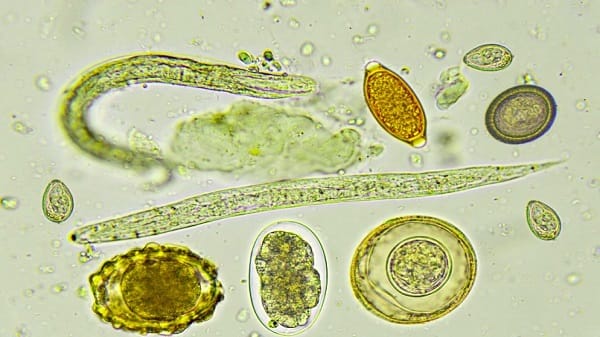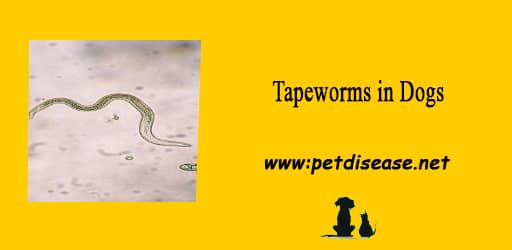As devoted pet owners, our dogs hold a special place in our hearts and homes. However, amidst all the love and joy they bring, our furry friends can sometimes face health challenges, including tapeworms in dogs.
In this post, we will explore the world of tapeworms in dogs, recognizing symptoms, exploring treatment options, and learning how to prevent future infestations.
What Are Tapeworms?
Tapeworms are parasitic flatworms that inhabit the intestines of dogs. These segmented worms can grow up to several inches in length and can release egg-containing segments into the dog’s feces.

Common Types of Tapeworms in Dogs
There are several types of tapeworms that can infect dogs, but the most common ones are:
- Dipylidium caninum, also known as the flea tapeworm, is commonly transmitted to dogs through fleas.
- Taenia tapeworms are contracted when dogs consume infected intermediate hosts, such as rodents or small animals.
How Tapeworms are Transmitted to Dogs: Routes of Infection
Tapeworms have complex lifecycles that usually involve an intermediate host before infecting the dog. The primary ways dogs get tapeworms are:
- Ingestion of Infected Fleas: The most common route of transmission is through the ingestion of infected fleas during grooming.
- Fleas act as intermediate hosts for Dipylidium caninum tapeworms, and when dogs accidentally swallow infected fleas, they become infested with tapeworms.
- Consumption of Infected Prey: Dogs that have access to the outdoors and engage in hunting or scavenging activities are at risk of contracting tapeworms through the consumption of infected intermediate hosts like rodents or small animals.
- Contaminated Environments: In some cases, dogs may pick up tapeworm eggs from contaminated environments, such as parks or gardens, where infected animals have shed tapeworm segments.
Can Tapeworms Be Passed From Dog to Dog?
Direct transmission of tapeworms from one dog to another is rare.

However, if an infected dog defecates in an area, and another dog comes into contact with the contaminated feces, they may ingest tapeworm eggs and become infested.
Can Humans Get Tapeworms from Dogs?
The good news is that the types of tapeworms commonly found in dogs are not directly transmissible to humans. The parasites that affect dogs have specific lifecycles and typically require an intermediate host before becoming infectious to other animals, including humans. For example, the most common tapeworm in dogs, Dipylidium caninum, requires the ingestion of infected fleas.
Tapeworms in Dogs: Symptoms
- Visible Tapeworm Segments in Feces or Around Anus: One of the most obvious signs of tapeworm infestation is the presence of small, white, rice-like segments in the dog’s feces or around its anus. These segments contain tapeworm eggs and are often easily visible to the naked eye. If you notice these segments, it indicates an active tapeworm infection.
- Anal Itching or Scooting: Dogs with tapeworms may experience irritation and discomfort in their anal area, leading to frequent licking, biting, scooting, or dragging their bottom on the ground. This behavior is a response to the irritation caused by tapeworm segments near the anus.
- Unexplained Weight Loss: Tapeworms can absorb nutrients from the dog’s food, leading to weight loss over time. If your dog is losing weight despite having a regular appetite, it could be a sign of a tapeworm infestation.

- Increased Appetite: In some cases, dogs with tapeworms may show an increase in appetite. The parasites consume a portion of the nutrients from the dog’s food, leaving them feeling hungry more often.
- Abdominal Discomfort: Dogs with tapeworms may experience mild to moderate abdominal discomfort, which can be indicated by restlessness, pacing, or whining.
- Lethargy or Fatigue: Tapeworm infestations can cause general fatigue and lethargy in dogs. They may appear less active or less interested in their usual activities.
- Dull Coat and Poor Coat Condition: Severe tapeworm infestations can lead to a decline in the dog’s coat condition, resulting in a lackluster appearance and overall poor coat health.
- Visible Tapeworm Segments in Vomit (in severe cases): In severe infestations, dogs may vomit, and tapeworm segments may be visible in the vomit. This is an alarming sign and indicates a significant tapeworm infestation that requires immediate veterinary attention.
Remember, not all dogs may show noticeable symptoms, so regular veterinary check-ups and preventive measures are crucial for your dog’s health and well-being. If you notice any of these symptoms or suspect tapeworm infestation, seek veterinary advice promptly for proper diagnosis and treatment.
Tapeworms in Dogs: Treatment
Dealing with tapeworms in dogs requires prompt and effective treatment to eliminate these parasites and ensure your furry companion’s well-being. Here are the common treatment approaches:
- Deworming Medications: Deworming medications are the primary treatment for tapeworms in dogs. These medications are available in various forms, such as tablets, chewables, or spot-on treatments. They work by killing the tapeworms, allowing the dog’s body to pass the dead worms through their feces.
- Prescription Medication: In some cases, tapeworms may require prescription medications from a veterinarian. These medications are more potent and effective against specific tapeworm species that may not respond to over-the-counter dewormers.
- Flea Control: Since fleas are a common source of tapeworm infections, controlling fleas is crucial in preventing re-infestation. Regular use of flea preventatives can help break the tapeworm lifecycle and reduce the risk of recurrence.
- Hygiene and Sanitation: Maintaining cleanliness in your dog’s living areas can help prevent tapeworm infections. Regularly clean and disinfect bedding, toys, and other items your dog comes into contact with.

- Regular Veterinary Check-ups: Regular visits to the veterinarian ensure early detection of tapeworms and other parasitic infections. Your veterinarian can recommend appropriate deworming schedules and preventive measures based on your dog’s individual needs.
- Dietary Changes: Providing a balanced and nutritious diet helps strengthen your dog’s immune system, making them less susceptible to parasitic infections.
- Follow-up Examinations: After administering deworming medication, your veterinarian may recommend follow-up examinations to ensure the tapeworms have been fully eliminated.
- Home Environment Management: If your dog has a habit of consuming rodents or other potential carriers of tapeworms, take measures to limit their exposure to these sources.
Preventing Tapeworm Infections
While tapeworm infestations are treatable, prevention is always better than cure. Here are some simple preventive measures:
- Regular Deworming: Schedule regular deworming with your veterinarian to eliminate any potential tapeworms and other intestinal parasites.
- Flea Control: Since fleas are common vectors for tapeworm transmission, implement flea control measures to reduce the risk of infestation.
- Good Hygiene Practices: Maintain good hygiene in your dog’s living area and promptly clean up feces to minimize exposure to tapeworm eggs.
Final Thoughts
Understanding tapeworms and their impact on dogs is essential for every pet owner. By staying informed and proactive, we can protect our beloved furry friends from these troublesome parasites. Regular veterinary check-ups, preventive measures, and swift action when needed are the keys to ensuring our dogs lead healthy, happy lives, free from the burden of tapeworms.

